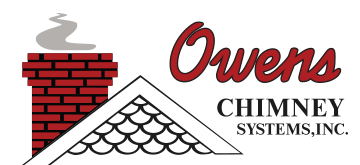If you are looking for a way to reduce your heating costs this fall and winter, you may want to consider a gas fireplace. Easy to operate and clean-burning, gas fireplaces give you the convenience of flipping a switch to ignite your fire. You will not have to worry about bringing in firewood or sweeping up ashes when you use a gas fireplace. Furthermore, many models of gas fireplaces are equipped with blowers that will evenly distribute the warmth throughout the room. At Owens Chimney Systems, we sell and install a variety of gas fireplace units from two of the industry’s leaders, Regency Fireplace Products and Fireside America. When you are looking at the different models of gas fireplaces, you will see that you have two options: direct vent and vent free. We would like to tell you about the differences between these two choices by sharing with you some information from Fine Homebuilding.
Direct Vent
A traditional vented gas fireplace requires a flue or a ventilation pipe to exhaust the byproducts of combustion out of the home, but a direct vent fireplace does not need a chimney or a vent through the roof because it can vent through a wall in your house. Instead of using indoor air for combustion, a direct vent fireplace uses outdoor air. This type of fireplace is equipped with a double vent pipe that pulls in outdoor air through its outer chamber and exhausts fumes through its inner chamber. Direct vent fireplaces are extremely safe as you do not have to worry about backdrafting, and the vent pipe can be installed with a fire-caulked flange. Since this type of fireplace is sealed off completely by glass doors, the majority of the fuel is converted into usable heat without any significant heat loss. You will also like the versatility of a direct vent fireplace as it can be installed anywhere in your home you would like. Available in different sizes and styles, Owens Chimney Systems is confident you can find a direct vent fireplace that is perfect for your house.
Vent Free
The biggest difference between a direct vent fireplace and a vent free fireplace is that no hole in the wall is required to install a vent free fireplace. With an efficiency rate of 99 percent, vent free fireplaces are designed and engineered to near-perfect combustion standards. You may have heard some negative things about vent free fireplaces being dangerous due to the possibility of carbon monoxide leaks, but when a vent free fireplace is installed, maintained, and operated properly, you should not experience any problems with this issue. You can trust the certified technicians at Owens Chimney Systems to correctly install your vent free fireplace and to teach you how to maintain and operate the unit safely. We can also help you deal with any condensation problems that may occur with this type of fireplace. Since there is no flue attached to a vent free fireplace, it can produce water vapor as a byproduct of combustion that can lead to condensation on your windows. However, our expert staff can help you solve this problem by supplying fresh air to combat the condensation.
Considering upgrading to a new gas fireplace or upgrading your existing gas logs to something more realistic looking? Contact us at Owens Chimney Systems to learn more about direct vent and vent free fireplaces and gas logs.
